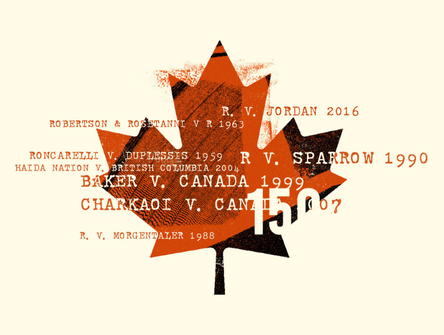Supreme Court upholds conviction, reaffirms inadmissibility of sexual history evidence
In a 7-2 split, however, the justices differed on whether that evidence could be revisited over the course of a trial.

The Supreme Court of Canada has unanimously upheld that a trial judge properly dismissed a request to introduce evidence of prior sexual activity in a sexual assault trial. In a 7-2 split, however, the Court differed on whether that evidence could be revisited over the course of a trial.
The Court also unanimously agreed that a Crown motion on a sealing order and in camera hearings were not necessarily binding at the appellate level, affirming that trials should be as open as possible while still protecting complainants' privacy and dignity.
In the case, the complainant and defendant were in a relationship for twenty years. When they separated, the defendant moved into the family home’s basement. One night, they had consensual sex, but the following morning, the complainant was sexually assaulted. The defendant, identified as T.W.W., initially claimed consent was given before denying any assault occurred. At trial, he wanted the evidence of prior sexual history from the evening before introduced.
The trial judge dismissed T.W.W.'s application, stating the events of the evening before (April 1) were not relevant to the issue of consent the next morning.
Section 276(1) of the Criminal Code prohibits evidence of prior sexual conduct, whether with the accused or any other person, to support an inference that the complainant is more likely to have consented to the alleged sexual activity or that the complainant is less worthy of belief.
“I agree with the majority that the trial judge did not err by finding that the evidence would invoke twin-myth reasoning,” Justice Michelle O’Bonsawain wrote for the majority.
“The fact that the parties here previously had a sexual relationship is uncontested and is admitted. For this reason, there could be no use for the April 1 evidence beyond twin-myth reasoning.”
Lisa Dufraimont, a professor at Osgoode Hall Law School who has published extensively on evidence issues in sexual assault cases, says the majority’s reasons were straight-forward and clarifying in upholding the law around preventing the twin myths involving sexual assault.
However, the chaotic nature of the application as it unfolded at trial seems to have extended into the appellate process, which meant the best argument for the admissibility of the evidence wasn’t made in Court.
“There was an argument for relevance of the other sexual activity evidence if the complainant was leaving the trier-of-fact with the impression that at this time in their relationship, she never would have had sexual interaction with him, when she admitted to having done so the day before,” Dufraimont says.
The two dissenting judges, Justices Suzanne Côté and Mary Moreau, felt the trial judge should have revisited his pre-trial ruling as the evidence unfolded. The majority said the question wasn’t raised in either party’s application or in the defendant’s factum, nor were there submissions on this issue at the hearing, so they opted not to rule on it.
“There is a worry that the accused may have been let down by his lawyers in not putting forward what really was the best argument for the admissibility of this evidence. But I can certainly understand why the majority of the Supreme Court decided why this was beyond the scope of the appeal,” Dufraimont says.
“It’s just unfortunate … because that’s the best argument the accused had.”
Writing about the motion for a sealing order and in camera hearing, O’Bonsawin said that any applicant seeking a limiting order must articulate a serious risk to the complainant’s privacy and dignity that warrants a greater restriction on court openness, which can’t be achieved by other measures. Relying on the test in the Sherman Estate decision, she didn’t feel the Crown established that in this case.
“Sealing orders and in-camera hearings are greater incursions on court openness compared to publication bans because they more absolutely limit public discourse on the subject information by preventing access to the protected material entirely,” O’Bonsawin wrote.
In the majority’s view, this flows from each court’s ability to control its processes and records.
Kyla Lee of Acumen Law in Vancouver, and chair of the Canadian Bar Association’s criminal justice section, says there could be an opening for mischief by not allowing these orders to carry through to the appellate level.
“I would imagine that there are going to be instances following this decision where neither Crown nor defence implores the court to say they need to exercise the power of their own process to continue the effect of the publication ban or not to publish details about sexual activity that wanted to be introduced, or relationship history that could identify a complainant,” Lee says.
“I worry because errors happen, and this interpretation that the Supreme Court of Canada has given could lead to harm.”
In such an instance, Lee says if information is inadvertently made public or not covered by the statutory publication ban, a nefarious person could use that information from an appellate decision to embarrass or humiliate a complainant after a matter has concluded.
“This could be an opening for sextortion,” Lee says. “The idea that there is not an automatic pathway to protecting this information, to me, treads a very fine line.”
To that end, she suspects a bill may be tabled in Parliament to continue these kinds of orders through an appellate process.
Regarding the introduction of records, Lee suspects this may have been a borderline case for introducing prior records.
“I do appreciate the clarification from the Court on how specific you need to be in your application to introduce these records to get them in the door because that is also going to help speed up processes,” she says.
“Since they complicated sexual assault law with all of these pre-trial applications, trials take a lot longer. But when judges engage in their screening processes, if counsel pays attention to being specific at the beginning, maybe less court time will be wasted on applications that have no hope of success.”


